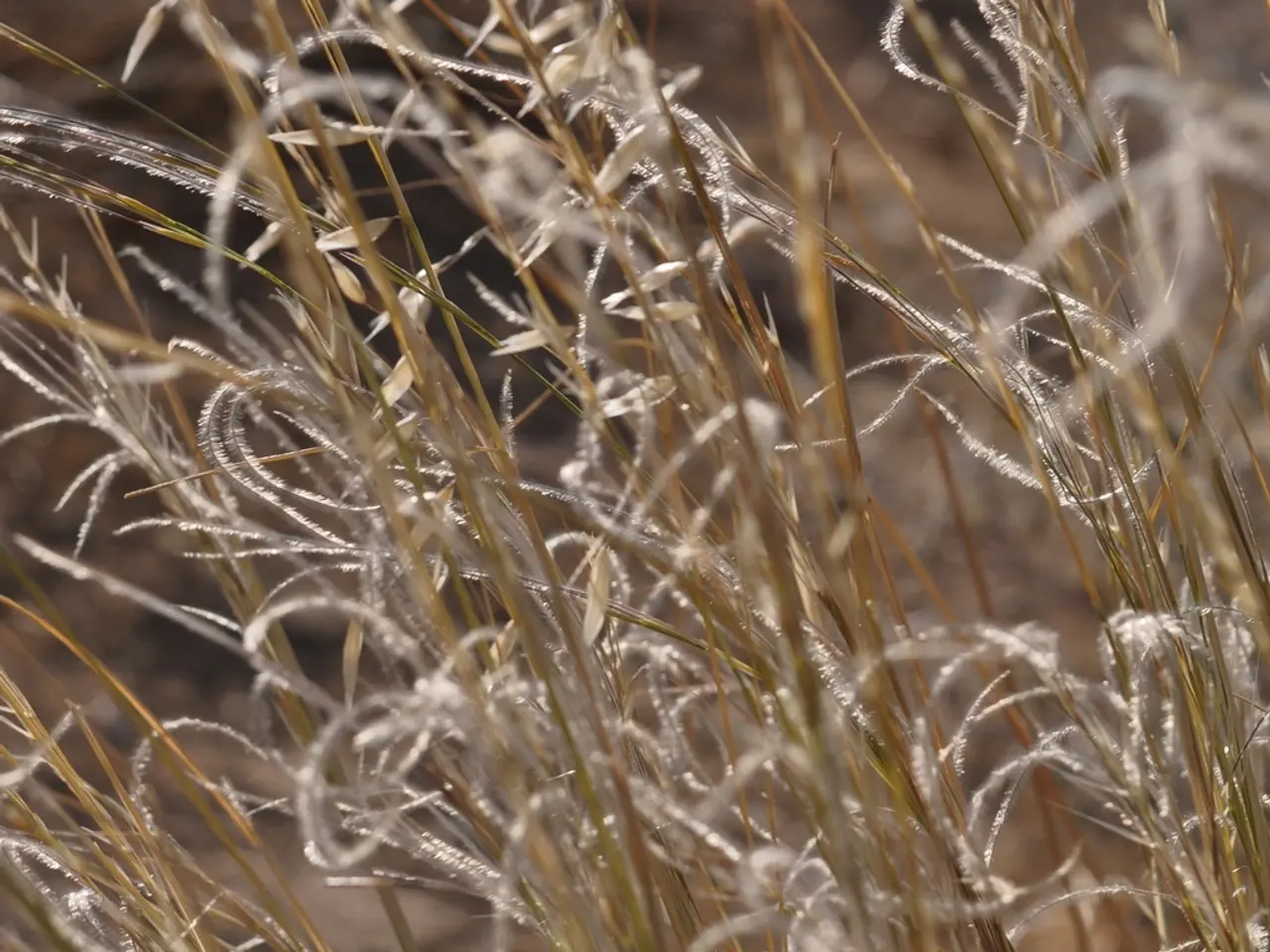Strategies for Maintaining Extensive Patchy Lawns During Spring's Blooms
In Iowa, maintaining a healthy, vibrant lawn can be challenging due to the presence of invasive warm-season grass weeds, such as nimblewill and zoysiagrass. These weeds, which thrive during the hotter months, can pose a significant threat to cool-season grasses like Kentucky bluegrass and perennial ryegrass, commonly found in Iowa lawns.
**Identification**
Nimblewill and zoysiagrass can be easily identified by their distinctive appearances and growth habits. Nimblewill forms dense, low-growing patches with fine, wiry leaves that are broader and softer than crabgrass. The stems are sprawling and root at nodes, forming thick mats. Leaves are blue-green and turn brown with frost, and the weed actively grows in late spring through summer, often persisting until frost.
Zoysiagrass, on the other hand, forms thick, dense mats with wide, wiry leaves. It spreads aggressively by rhizomes and stolons, creating large, uniform patches.
**Control Strategies**
Controlling these weeds involves both non-chemical and chemical methods. Promoting a thick, healthy cool-season lawn through proper mowing, watering, and fertilization is crucial to outcompete invaders. Mowing at recommended heights (often 3–4 inches) for cool-season grasses helps shade the soil and reduce weed establishment. Overseeding with cool-season grasses in the fall fills bare spots and strengthens cool-season turf, reducing openings for weeds. For small patches, hand-pulling or spot-digging weeds when soil is moist can also be effective.
When chemical control is necessary, selective herbicides are often difficult to use due to the close biology between warm-season grass weeds and turfgrass. For nimblewill, there are limited selective options, such as fenoxaprop (e.g., Acclaim Extra). However, its effectiveness is variable and dependent on application timing and turf species tolerance. Selective control for zoysiagrass and other perennial grasses is typically not available for homeowners.
Non-selective herbicides, like glyphosate, are often the most effective method for both nimblewill and zoysiagrass. Glyphosate kills all contacted vegetation, so it should be used only on small patches or where complete renovation is acceptable. After treatment, reseed with desired cool-season grasses. Application timing is crucial, with best results occurring when weeds are actively growing in summer and temperatures are above 75°F (24°C).
**Recommendations**
Prevention is key in maintaining a healthy lawn. Cultivating a thick, healthy lawn minimizes weed establishment. For small infestations, spot-treat with non-selective herbicide (glyphosate), then reseed. For larger or persistent infestations, consult a lawn care professional for advanced herbicide options. Always follow label instructions and consider turf tolerance when using herbicides to avoid damaging desirable grasses.
In spring, cool-season lawns in Iowa turn a vibrant green. However, occasionally, large "dead" patches of grass can be seen. If the grass does not appear to be a different species, the large brown patches could have been killed from winter drying. To reseed a dead spot, remove some of the dead, dry grass with a rake, mix a small amount of garden soil with the grass seed, and spread it over the spot. Water the seeded area regularly until it germinates, with daily watering possibly needed if it doesn't rain.
Similar brown patches can form along heavily salted sidewalks or driveways due to the high concentration of salt. Reseed areas killed by excessive dog urine or salt in the same way as areas killed by winter drying.
For more information on overseeding a lawn, refer to the article titled "Overseeding a Lawn". Tenacity (mesotrione) is a systemic herbicide that selectively controls the two most common warm-season grassy weeds in bluegrass lawns, nimblewill, and zoysiagrass. Three applications (at two-to-three-week intervals) of Tenacity are usually necessary to control these weeds. The area should green up in two to four weeks, and over time, the color and texture should blend with the surrounding grass.
- To identify nimblewill, one can observe its low-growing, dense patches with fine, wiry leaves that are broader and softer than crabgrass, while zoysiagrass forms thick, dense mats with wide, wiry leaves.
- Controlling warm-season grass weeds like nimblewill and zoysiagrass requires both non-chemical and chemical methods. Maintaining a thick, healthy cool-season lawn through proper care and overseedding in the fall helps reduce openings for weeds.
- When chemical control is necessary, non-selective herbicides like glyphosate may be used on small patches or complete renovation areas. However, its use should be timed carefully, with best results achieved when weeds are actively growing in summer and temperatures are above 75°F (24°C).
- Preventing weeds in a lawn begins with cultivating a thick, healthy lawn to minimize weed establishment. For small infestations, spot-treat with non-selective herbicide (glyphosate), then reseed. For larger or persistent infestations, consult a lawn care professional for advanced herbicide options.




